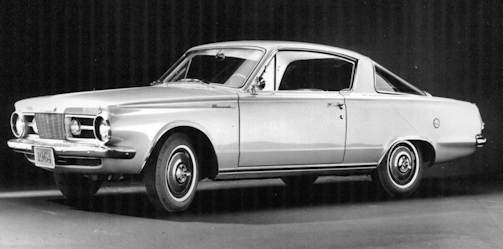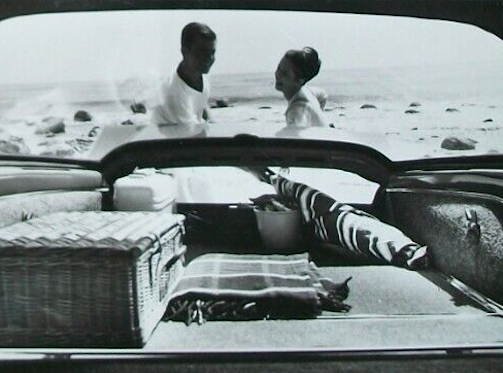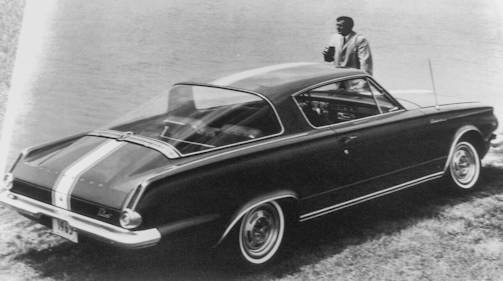Plymouth Barracuda First generation
 |
|
|
Production |
1964 to 1966 |
|
Designer |
Elwood Engle |
|
Class |
Sports car |
|
Body style |
2-door fastback coupe |
|
Platform |
A-body |
|
Drive |
Rear wheel |
|
Related |
Plymouth Valiant |
|
Engine |
|
|
Wheelbase |
106 in (2,692 mm) |
|
Length |
188 in (4,775 mm) |
|
Width |
70 in (1,778 mm) |
|
Height |
52.5 in (1,334 mm) |
|
Curb weight |
3,100 lb (1,406 kg) |
The Plymouth Barracuda 1st generation is a two-door car that was manufactured by Plymouth in the 1960s.
History
All automakers in the US brought sports compact cars on the market in the early to mid-1960s. Chrysler chose as the basis for the model Plymouth Valiant. The Ford Mustang, which eventually sold significantly better than the Barracuda, made the designation of this vehicle class as a " pony car ", but the Plymouth Barracuda Fastback appeared two weeks earlier, on April 1, 1964. The management of Plymouth actually wanted the car Call "Panda" what the designer did not like. Finally, John Samsen prevailed with his proposal "Barracuda".

The Barracuda had the wheelbase of the Valiant Chrysler A-body with 2,692 mm, the hood, the frames of the headlights, the windshield, the front triangular windows, the fenders and the bumpers; all other sheet metal parts and windows were new. This approach reduced the cost of development, tools, and development time for the new model.
The hatchback was designed with a 1.3 m² panoramic rear window, which was pulled up to the B-pillar. This largest window to date used in passenger car series production was manufactured by Pittsburgh Plate Glass (PPG). In model year 1965, the fenders and taillights of the 1964 Barracuda for the Valiant were taken (except for the station wagon, which got its own taillights).
The fastback styling is accentuated by the Largest rear window. 14. 4 square feet, ever installed in a production automobile. The window is of tinted glass. With the rear seat-back folded forward, there is ample cargo space for luggage, picnic baskets, even water skis. Cargo may be easily loaded through the opened deck lid. in addition, the Plymouth Barracuda has a security panel which creates the concealed locked storage compartment. It can be released to fold flat from inside the trunk.

The mechanics corresponded to those of the Valiant parts and bodywork except for the distinctive wraparound rear glass with a chrome band across the rear window base, including two versions of the Chrysler Slant-6 engine, a 2.8-liter engine with 75 kW in the basic configuration and an optionally available 3.7-liter with 108 kW.
- Performance: 225 cu in
- Torque (SAE): 215'b ft. 29.1 m at 2,400rpm
- Max engine rev: 4.600
- Specific power: 39.3 hp/l
- Power-weight ratio: 19.2 lb/hp. 8.7 kg/hp:
A brand new 4.5-liter Chrysler LA-V8 with 134 kW and a twin carburettor was the largest engine for 1964; the performance was initially quite low.
The base price for the Barracuda was $ 2,512, the Barracuda debuted in fastback form on April 1, 1964 this was not only the first year for the Barracuda, but also the last year when the Torque flite push-button automatic was offered; Thus, the VV1-P 1964 Barracuda was the only one with this equipment. The 1964 Barracuda sales totalled 23,443 units Standard equipment included bucket front seats; bucket shaped rear bench seat with folding back rest.
In model year 1965, the 3.7-liter engine became the base engine for the US; in Canada, this remained the 2.8-liter. As the competition in the "pony-car" segment tightened, there were new optional extras: a Commando version of the 4.5-liter engine with quad carburettor, a compression ratio of 10.5: 1, a sharper camshaft and other improvements introduced, which made 175 kW. In addition, there was the Formula-S package, which included except the Commando V8 a reinforced suspension, larger wheels and tires, special emblems and a tachometer. Disc brakes and factory air conditioning were introduced at the beginning of the model year.
In 1966, The 1966 Barracuda was redesigned towards the front and largely unchanged at the rear with new taillights, a new front and a new dashboard. The latter provided space for oil pressure gauge and tachometer. The front of the vehicle, with the exception of the radiator grille, shared the 1966 Barracuda with the Valiant of the same year, giving the front fenders a more angular shape. The deluxe models also had flasher-mounted indicator lights in the fins a vinyl top was a new option. The bumpers were larger and the grille had a solid grid. For the first time there was a centre console on request. The 225 cubic inch 145 horsepower Slant SIX was standard in the BVI-P Series Barracuda.
Although the first Barracudas looked very similar to the contemporary Valiant, they wanted Plymouth to be understood as a separate model series. So, they gave the "Valiant" lettering, which still appeared on the trunk lid of the 1964 models, 1965 on. In 1966, the cars were equipped with a Barracuda-specific, stylized fish logo, only in export markets such as Canada and South Africa, where Valiant was marketed as a separate car brand, remained the name Valiant Barracuda until the A-Barracuda was set in 1969.
The Barracuda also influenced the design of other Chrysler vehicles. Across the Atlantic, the Chrysler company in the UK, the former Roots Group, developed the Hill beam Hunter- based Sunbeam Rapier hatchback coupe in 1967, which showed striking parallels with the 1964-1966 Barracuda, though styling-responsible design Director of Roots, denied any direct connection.

Technical
-
Plymouth Barracuda 1st gen Technical details and specifications (1964-1966)
ENGINE: 225 cu in
location front
bore end stroke: 3.40 4.12 in. 86.4 x 104 mm
Engine capacity: 225 cu in, 3.687.07 cu cm
compression ratio: 8.4
cylinder block: cast iron
heed: cast iron
cranksheft bearings: 4
valves: 2 per cylinder. overhead.
cam shafts: 1, side
lubrication: rotary pump, full filter
carburation: 1 holly R-3271 downdraught single barrel cerburettor
fuel feed: mechanical
cooling: water
(Optional) cleaner air systemTRANSMISSION
driving wheels: rear
clutch: single dry plate
gearbox: mechanical
Gears 3 plus reverse
gearbox ratios: 1st 2.950,2nd 1.830 3rd 1 rev 3.800
(Optional) Torqueflite automatic gearbox with 3 ratios (1 2.450. Il 1.450. Ill 1, rev 2.200)
gear lever: steering column
final drive: hypoid bevel
axel ratio: 3.230. (Optional) 3.550 3.330
(Optional) limited slip finalSUSPENSION:
front suspension: independent. wishbones. lower trailing longitudinal torsion bars. telescopic dampers
rear suspension: rigid axle,leafsprings, telescopic dampers.STEERING:
recirculating ball
turns of steering wheel lock to lock: 5.30.
turning circle (between watts): 39.9 ft. 12.2m
(Optional)power-assisted steeringBRAKES:
drum; area rubbed by linings: total 254.50 sq in
(Optional) servo brake
(Optional) front disc brakes (diameter 11.12 in. 282 mm)total area rubbed by linings 266.10 sq in. 1,716.34 sq cmELECTRICAL EQUIPMENT
voltage: 12 V
battery: 48 Ah
ignition distributor: ChryslerDIMENSIONS AND WEIGHT:
wheel base: 106 in, 2.692 mm
front track: 55.90 mm
rear track: 55.60 in. 1,412 mm
overall length: 188.30" in. 4.783 mm
width: 70.20 in. 1,783 mm
overall height: 53 in. 1.346 mm
ground clearance:5 in
dry weight: 2,776 lb. 1.259 kg© Motor car History
Service
-
Plymouth Barracuda 1st gen Maintenance and Service Guide (1964-1966)
Gearbox oil 13.38 imp pt. 16 US pt. 7.61. AQ-ATF Suffix A
Greasing: every 32,000 miles. 51.500 km
Normal tyre pressure: front 24 psi 1.7 atm. rear 26 psi. 1.8 atm
Fuel tank capacity: 15 imp gat. 18 US galENGINE: 225 cu in
Fuel: 90 oct petrol
Engine sump oil: 6.69 imp 8 US pt SAE 5W-20 (winter) 10W-3O (summer), change every 4000 miles.
Total lubricating system capacity: 8.27 imp pt. 10 US pt. 4.7 1
Gearbox oil 13.38 imp pt. 16 US pt. 7.61. AQ-ATF Suffix A
Final drive oil: 1.58 Imp Pt. 2 US 0.91. SAE 80-90 change every 32.000 miles, 51.500 km
Cooling system capacity: 21.65 imp pt. 26 US pt,
Tappet clearance: inlet 0.010 in. 0.25 mm hot. exhaust 0.010 in. 0.25 mm hot
Valve timing: inlet opens 10° before tdc and closes 50° after bdc. exhaust opens 50° before bdc and closes 6° after tdc
© Motor car History
